![Richard Ledes on Seriema (Ismenia Mendes) with the analyst (David Patrick Kelly) in Adieu Lacan: “The costumes [by Kathryn O'Reardon] were very important.”](/images/newsite/Ismenia_Mendes_David_Patrick_Kelly_600.webp) |
| Richard Ledes on Seriema (Ismenia Mendes) with the analyst (David Patrick Kelly) in Adieu Lacan: “The costumes [by Kathryn O'Reardon] were very important.” |
Adieu Lacan (Adieu, Lacan), based on the book The Parrot And The Doctor, aka Lacan’s Parrot, and the play Goodbye, Doctor by Betty Milan, who was in analysis with Jacques Lacan in the 1970s in Paris, addresses a number of vital issues that are as relevant today as they were then. Richard Ledes and cinematographer Valentina Caniglia use the camera in this black and white movie to explore, at times in amusing ways, the power dynamics at play.
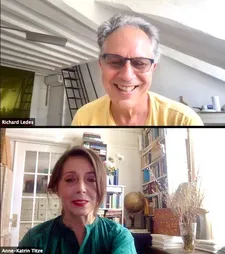 |
| Richard Ledes with Anne-Katrin Titze on Bill Raymond: “He’s so wonderful. We’ve done three films together and worked on a fourth.” |
“Now she has stopped being against herself” concludes the analyst (David Patrick Kelly, resembling Sam Shepard, Samuel Beckett or John Huston) about Seriema (Ismenia Mendes) when it is time to say adieu Lacan. The journey to this point is the journey of the film, one session at a time, some shorter, some longer, as was the style for Lacan, one of the most original thinkers of the 20th century. Seriema has no trouble calling out the doctor when she overhears him in the next room describing her as “the little Brazilian woman” to his assistant Gloria (Antu Yacob), her issues lie elsewhere as the unconscious is the discourse of the Other.
The costume design by Kathryn O'Reardon is intricate and thought-provoking, with Lacan oscillating between the extremes of buttoned-up shirts, complete with an extra throat latch (hinting at the tab collar of priests?) to a dressing gown and house slippers.
Seriema also signals protection and personal style with the pants and blouses (one with a pussy bow during a tense session), displaying her state of mind as far as the “sealing of the body” is concerned. It is a decision we all make every day getting dressed.
This Lacan keeps ritualistically saying “I’m listening” during the sessions, while his body language and facial expressions shift from devilish grin to deep concern to fatigue with the changing light. Knowing that “ancestors return, they don’t cease to exist” and freeing yourself from the father’s desire go hand-in-hand.
“You can get on a new path, reinvent your own history” - that’s the promise.
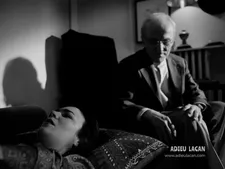 |
| Richard Ledes on David Patrick Kelly with Ismenia Mendes: “Being able to work with Ismenia, who’s a young starting actor and to be able to focus on listening to her, he really enjoyed.” |
From Paris, Richard Ledes joined me on Zoom for an in-depth conversation on Adieu Lacan.
Anne-Katrin Titze: Hello!
Richard Ledes: Hi, Anne-Katrin! Enchanté!
AKT: You’re in Paris?
RL: Yes, somebody has to do it.
AKT: How is Paris at the moment? Is spring springing?
RL: It’s really nice, I have to be honest. It’s very pleasant and people are out.
AKT: Let’s talk about Adieu Lacan! How did you first encounter the Imaginary, the Symbolic, and the Real?
RL: I was asked by a friend to write a version of the Antigone. That day I read in Le Monde the obituary of Laurence Bataille. And it mentioned that her stepfather, Jacques Lacan, had brought to her when she was in prison for her actions in support of the anti-colonial movement in Algeria his seminar on Antigone in the 7th Seminar.
So I took this as a sign. And it wasn’t published yet. I knew Ancient Greek and I read the Antigone and my French was very bad, so I went to the École de la Cause freudienne and I read it. So that was the first time I connected to the work of Lacan. I’m thinking about how those early interests are reflected in this film in certain ways. There’s the dimension of colonialism.
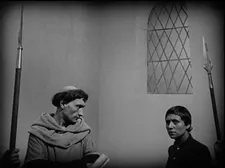 |
| Jean Massieu (Antonin Artaud) with Joan (Maria Falconetti) in Carl Theodor Dreyer’s The Passion Of Joan Of Arc |
AKT: Very much so and in a very interesting way! At one point in the film the Lacan character tells her “You’re as ashamed of your body as of your origins.” It’s a central point!
RL: Right! It’s a combination of her [Betty Milan] play and her novel, which she wrote about her analysis with Lacan. The one thing I took from the novel is really the prologue and that was to underline when she goes saying, “well, I’m not going to waste any time talking about being an immigrant. Nothing could be less relevant.” And of course it becomes the most relevant as she begins to talk about her father, her family’s experience and the effect it’s had on her.
Of course she also says her father worked like a slave and that in the end Lacan said “You didn’t free yourself from your father to be enslaved to your analyst.” I was aware of course of the history of slavery in Brazil, so I was interested in that as well. I had recently read a book by Susan Buck-Morss on Hegel, called Hegel, Haiti, and Universal History, which talks about Hegel’s premises about master/slave to the Haitian revolution and I had known through [Alexandre] Kojève in Lacan’s work his interest.
AKT: There is also the line, apropos slave, that the “Father who enslaved his daughter made motherhood impossible for her.” And this sums up what is going on. There are sentences so perfectly honed but it is as if we have to earn those sentences. It’s very funny actually when you have the moment of split screen when she “conquers the couch.” She’s climbing up! Talk a bit about the moments of humour in the cinematography!
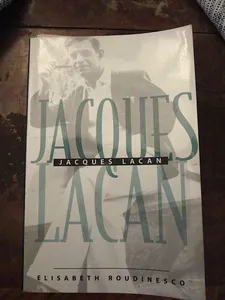 |
| Elisabeth Roudinesco’s biography on Jacques Lacan, collection Anne-Katrin Titze Photo: Anne-Katrin Titze |
RL: Yes, well I had looked at the series In Therapy and decided that was exactly what I did not want to do. I was not interested in this model of a very balanced relationship. I mean it’s beautifully done, it’s not a criticism of the series, nor the way it was shot, but it was just very different, very balanced.
AKT: Well, the series is about therapy and your film is about analysis - two very different things.
RL: Yes!
AKT: Did you see Arnaud Desplechin’s Jimmy P: Psychotherapy Of A Plains Indian?
RL: No.
AKT: Have you seen Deception? Are you familiar with his films?
RL: No, I’m afraid not.
AKT: You will be now!
RL: Great! For this we really took Carl Dreyer’s Joan of Arc as the model for the camerawork to get across a sense of transference, a sense of guilt and culpability. Also we shot it in sequence which was great. Because it’s all in one location we could do that. The crew was often thinking Valentina [Caniglia, the cinematographer] and I were a little insane and had lost it. The split screen, it was in some ways playing off the split signifier, the signifier and the signified in this moment of language and sexuality.
AKT: Another interesting moment is when you have the little statue totem overlap with Lacan’s face. He becomes that, I don’t know, object cause of desire.
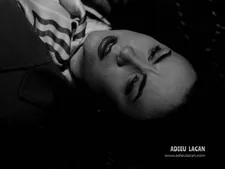 |
| Seriema (Ismenia Mendes) also signals protection and personal style with the pants and blouses … |
RL: Yes, and then the fetish - that’s the only hand-held shot. We tried to be very spare in our use of the camera. I was interested in this idea of Paul Schrader’s transcendental cinema. Having what Freud called this kind of “floating attention” and such. In the fetish you have the overlap of the social with the private. And Lacan’s work with the role of the nanny and such. Again it was a joy being on the floor and finding that shot.
AKT: A certain playfulness that can also be found in Lacan. His embrace of magical thinking, as we know, ghosts are from the realm of the Real. You say it was shot in chronological order and I think the audience senses that. We watch the actors growing into the roles. In the beginning there is a hesitancy and then they become more and more familiar with the thinking.
RL: Yes, you know, David Patrick, DP as he prefers to be called, fell in love with Jacques Lacan. It was so sweet in a way. Being able to work with Ismenia [Mendes], who’s a young starting actor and to be able to focus on listening to her, he really enjoyed. And also Lacan was a real performer.
There are a couple of things I learned about analysis. One was, Lacan as a performer, and perhaps also particularly during the time of the pandemic when we’re on Zoom so often, what it means to be in the same room with someone. Then of course Lacan’s thing of cutting and her frustration.
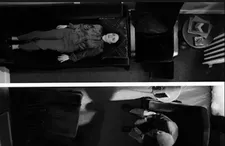 |
| Richard Ledes: “The split screen, it was in some ways playing off the split signifier …” |
AKT: I found it interesting how different the Lacan figure looks within the film. At times he is very devilish, it looks as if you put eyeliner on him. At other times he is slouching in the chair and there’s some Sam Shepard, some Beckett, some John Huston. Suddenly he looks like other people which I found quite fascinating.
RL: David Patrick Kelly and I bonded on the first day when we realized that we both studied mime in Paris. So we talked about Samuel Beckett and a particular friend who had played Molloy. Where Molloy is taking pebbles and is trying to decide which pocket and so we used that as a model for the money.
And yeah, John Huston and there’s a bunch of different manifestations. He’s a much more warm character than many people know Lacan from [Elisabeth] Roudinesco’s biography. I had a very good friend, Alain Didier-Weill, who had written Quartier Lacan, who was analyzed by Lacan. Through these people there’s a sense of warmth to the character.
AKT: True, the warmth is astounding in the film; I also expected a much colder Lacan. I noticed you took great care with the costumes. His collar for instance, the Lacanian collar, and also her wardrobe changes. In a pivotal moment she is wearing this pussy bow blouse, as it’s called. Tell me a bit about the work on the costumes!
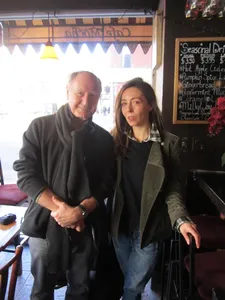 |
| Bill Raymond with Anne-Katrin Titze in the East Village Photo: Ed Bahlman |
RL: The costumes were very important. We wanted to have a sense of the analysis starting to have an effect on her through her costuming in a sense of her being more open and less tightly bound, you could say. For Lacan, he was again very playful, dandy. Curiously enough, having David Patrick Kelly - David Lynch also always has this closed shirt in the front, which is really interesting.
Despite that very buttoned-up quality literally, there’s his playfulness. One time he comes in his pajamas, which was in fact an anecdote told from the book Quartier Lacan, of interviews conducted by my friend Alain. For her we wanted to see a change over time whereas for Lacan it’s more this devilishness, as you say, his playfulness coming across.
AKT: I saw you have been working with Bill Raymond!
RL: Yes, he’s so wonderful. He was in my first feature film [A Hole in One] where he played the lobotomy doctor. We’ve worked together a number of times since then. He comes out of the theater group Mabou Mimes.
AKT: Mabou Mimes, yes.
RL: I liked working with Bill Raymond.
AKT: I know him, but I haven’t been in touch recently so I was wondering if you had been. He’s a lovely person.
RL: Lovely, yes, living over in the East Village with Linda. I wrote him probably about a year ago. I didn’t hear back so we’re a little bit out of touch. We’ve done three films together and worked on a fourth. Maybe devil is the word of the day, he’s kind of a devilish character, we have a lot of fun together.
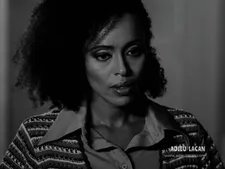 |
| Antu Yacob as the analyst’s assistant Gloria in Adieu Lacan |
AKT: Talking of the devil, I thought of Hitchcock’s Marnie at one moment during the thunderstorm analysis session. Remember that scene when the branch falls through the window? Were you thinking of Marnie at that moment?
RL: Not consciously.
AKT: Well, there is an unconscious, you know?
RL: There very much is! It’s so funny, usually I have a few conversations about a film, but with this film we brought it out in prerelease for these groups and I’ve been meeting with Lacanian psychoanalytic associations throughout Argentina and Brazil and Mexico and France and all over the place. Often I speak as if I knew all these things beforehand, but really … I go, oh yeah!
AKT: It’s a wide field! Another line that I loved is “Ancestors return, they don’t cease to exist.” It’s powerful in the context of the colonialism, of course.
RL: It’s interesting, the relation of cinema to ghosts. One of the films Bill Raymond and I did involved the history of racism in the US and I remember going back and seeing Birth of a Nation. The scene where the founder of the Ku Klux Klan is in the woods, things are going so bad he can’t think of what to do.
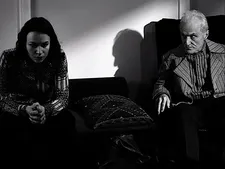 |
| Richard Ledes on Ismenia Mendes and David Patrick Kelly: “For her we wanted to see a change over time whereas for Lacan it’s more this devilishness, as you say, his playfulness coming across.” |
And then these white children have white sheets over them and it scares the Black children and he goes “Ha!” The white sheet for me was also the screen of cinema and had this great power. And the notion of ghosts, of phantoms.
AKT: That’s what cinema is, dead people coming back in an eternal return. It’s a visitation.
RL: Absolutely.
AKT: Absolutely it sometimes feels that way. The undead go well with the sentence in your film about the ancestors returning.
RL: The script really comes out of Betty Milan’s work, her analysis. I was very fortunate. I was invited by a Psychoanalytic Association in New York, Après-Coup, of which I’ve been a member for longer than I care to say and they asked me to direct the stage reading of the play. I was so struck by the possibility that I could make a film. It as so much more accessible than Lacan’s work is usually considered. That came out in the setting, the practice of psychoanalysis and made it much easier to understand.
AKT: That’s very true. I remember when I first was reading Lacan at university my dreams changed. It felt as if the structure of my dreaming changed. What is the parrot in Betty Milan’s book referring to?
RL: The parrot is her own relationship to Lacan. She originally went to Paris to bring back to Brazil his ideas. Then in the midst of this personal crisis she decided to do an analysis. And she has since written a third book on Lacan during the pandemic. It’s now out in French, called Pourquoi Lacan. I think that’s her third and final work about her analysis with Lacan.
AKT: Thank you for the film and the conversation. Enjoy Paris!
RL: I’ll do my best. Nice to meet you and thank you!





















